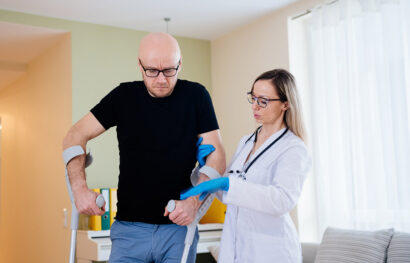In practice, I see patients every day who have had subpar results with a variety of different knee pain treatments.
To understand why these treatments are failing, it’s first important to know what type of knee pain patients I am referring too. This is the patient who hasn’t had a major event that has led to a knee injury, but rather over time has developed knee pain. With these types of cases there are two things that are often overlooked, and both are derived from the same issue: loss of proper joint function. Loss of joint function can occur for several reasons. For example, it can occur when muscles around the joint over tighten or weaken or with a change in gait due to muscle imbalance. The two most common reasons I see are patellar tracking and Varus deformity.
Patellar tracking is when the patella moves more to one side than the other when the knee is bent.
On an X-Ray it may be seen in a standing position because of over-tightened muscles on one side and weak on the other, and because of a Varus or Valgus change in positioning.
This is an issue because articular cartilage is the hard cartilage that is under the kneecap
and if the kneecap or patella is moving outside of the patellar groove, where this cartilage sits, then friction increases against the kneecap and the femur. This results in degeneration and arthritis, and ultimately knee pain.

Varus deformity is an inward angulation (medial angulation, that is, towards the body’s midline) of the distal segment of a bone or joint.
The opposite of Varus is called Valgus. So in these cases, patients typically have decreased fluid volume or joint space to begin with and then this change in positioning occurs and causes friction on the side of the joint that is most displaced. This leads to degeneration, meniscus damage, osteoarthritis and of course knee pain.

What does this have to do with failed knee treatments?
A lot. Let’s go over the most common treatments: Cortisone Injection, Orthoscopic Meniscus Repair, Hyaluronic Acid Injections and Regenerative Medicines.
Cortisone Injection; If done on a patient with either or both conditions, will likely have short-term pain relief, but at a huge price.
We now know that cortisone does two things beside decrease inflammation in a joint. The first is that it increases osteoporosis by 4-8% in the injected area. So if you have just received one of these and have either or both these conditions you are going to rapidly increase the rate for developing degeneration and osteoarthritis. The knee is a weight bearing joint and it’s just been softened by the cortisone shot. The second thing cortisone does, since it’s acidic, it dries out the joint, so if you think of the meniscus being like a sponge, what happens to a dry sponge when it is twisted? It will tear. That’s what it does when a Varus position is present.
Orthoscopic Meniscus Repair;
In a Varus position it is not uncommon to see meniscus damage on the medial side. However, that may be a source of pain but not the cause of the pain. Yes, the damage to your meniscus is causing pain but the Varus position is what damaged it and thus is the cause of the pain. So, getting it cut out will not alleviate the pain, but will only allow for a bone-on-bone situation to develop. There are some good reasons to get orthoscopic surgery, but when a Varus is present this issue needs to be taken care of first or directly after the procedure to ensure a favorable outcome.
Haurlronic Acid (HA) Injections;
This is a natural, safe method to treat knee pain and to slow or stop osteoarthritis and degeneration. Unfortunately, if the condition is not properly assessed due to lack of knowledge or lack of due diligence by some providers, the results will be subpar at best. With a Varus position the HA cannot get under both sides of the bone, on the medial side it is pushed over to the lateral side and thus is much less effective. HA will lubricate and, in some cases, help with cartilage healing but in a patellar tracking patient whose pain is coming from articular cartilage damage it will not help because, #1 it can not heal articular cartilage only Regenerative Medicine can and, #2 the knee cap is rubbing against the femur and further damaging it.
Regenerative Medicine Injections;
Regenerative Medicine is by far the most superior in terms of knee treatments by regenerating meniscus and healing articular cartilage. It also regenerates the joint. However, it does not fix loss of function, the best outcome isn’t from the injection of the new tissue alone. In a Varus position and with a patellar tracking issue, the new cells will be damaged like the previous cells were over time. So, this new tissue will have the same result as the original tissue did because what caused the issue, in the beginning, hasn’t been resolved.
Core Medical Center’s Approach to Treatment has Better Outcomes & it Requires MORE Than Just the Regenerative Medicine Injection:
First, we must correct these two functional issues if they are present. In the case of the Varus deformity an off-loading brace is needed in order to pull the femur and tibia apart to make space. Then a therapy regime specific to correcting a Varus deformity should be prescribed and executed.
In the case of patellar tracking, often a Varus or Valgus is present so this must be corrected and if it’s a lateral tracking issue the muscles must be strengthened and stretched. This also requires a specific therapy regime.
If you experience knee pain and your doctor recommends one of the treatment options listed above, be sure to ask what is causing your knee pain and how this treatment will help.
If you are sent to therapy, make sure to ask what functional issue they are trying to rehabilitate. If they do not have an answer, then they do not really know, and you need to find a provider who does.




